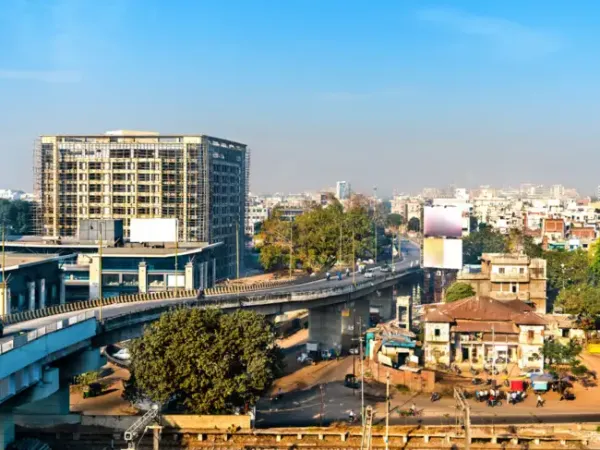For decades, the story of professional success in India was synonymous with the rush of metro cities—the fast trains of Mumbai, the towering skyline of Gurgaon, and the glass-and-steel campuses of Bengaluru. But now, in a post-pandemic world of flexible work and decentralised economies, a new narrative is emerging—one that belongs to smaller cities quietly blooming with opportunity.
According to a new report by LinkedIn titled 'Cities on the Rise', India’s smaller towns—once viewed merely as places of origin or retirement—are evolving into magnets of economic promise. With over four in five Indian professionals looking to change jobs this year, these cities are not just viable alternatives but, in many ways, the new frontier of growth.
“Tier 2 and tier 3 cities are at the heart of India’s economic transformation,” said Nirajita Banerjee, LinkedIn India’s Senior Managing Editor. “This means, for many Indians, meaningful career progress no longer demands moving to a big city.” The shift is being driven by investments from tech giants, government infrastructure plans, and the aspirations of local talent ready to stay rooted while reaching new heights.
In Raipur, the Chhattisgarh government’s vision for ‘Naya Raipur’—a tech-forward smart city—is attracting semiconductor and AI firms. Rajkot, meanwhile, is marrying tradition with sustainability through initiatives like eco-schools and sponge city planning, all while boosting MSME growth.
Vadodara is flourishing with construction and transport projects. Ranchi’s smart city infrastructure is drawing professionals from across Jharkhand. And in Agra, the New Agra project, with proposed manufacturing clusters worth ₹1,046 crore, is blending Mughal legacy with a modern industrial push.
These rising cities offer more than just employment. They offer affordable housing, lesser pollution, tight-knit communities, and growing lifestyle options—all without the daily grind of metro chaos. LinkedIn’s data suggests that professionals are now open to staying closer to their roots if the city can match their ambition. Increasingly, these cities can.
Whether it’s Raipur’s ₹4.5 lakh crore investment proposals or Jodhpur’s startup-friendly work culture, the momentum is unmistakable.
So, if you’ve ever wished for a slower pace of life without compromising your ambition, perhaps the future isn’t in getting out—it’s in going back.
According to a new report by LinkedIn titled 'Cities on the Rise', India’s smaller towns—once viewed merely as places of origin or retirement—are evolving into magnets of economic promise. With over four in five Indian professionals looking to change jobs this year, these cities are not just viable alternatives but, in many ways, the new frontier of growth.
The Rise of India's "Next" Cities
The list, powered by exclusive LinkedIn data, identifies 10 non-metro cities where job creation, hiring momentum, and professional migration are on a significant upswing. From Visakhapatnam’s tech boom to Jodhpur’s rising start-up ecosystem, each city on the list offers a distinct flavour of growth.“Tier 2 and tier 3 cities are at the heart of India’s economic transformation,” said Nirajita Banerjee, LinkedIn India’s Senior Managing Editor. “This means, for many Indians, meaningful career progress no longer demands moving to a big city.” The shift is being driven by investments from tech giants, government infrastructure plans, and the aspirations of local talent ready to stay rooted while reaching new heights.
What’s Driving the Boom?
A potent mix of local entrepreneurship, government support, and large corporate interest is fuelling this change. Cities like Visakhapatnam and Madurai are becoming hubs for data, IT, and pharma industries. Companies like HCLTech, Infosys, Sun Pharma, and Dr. Reddy's Laboratories are setting up shop in these regions, offering not just jobs but entire ecosystems.In Raipur, the Chhattisgarh government’s vision for ‘Naya Raipur’—a tech-forward smart city—is attracting semiconductor and AI firms. Rajkot, meanwhile, is marrying tradition with sustainability through initiatives like eco-schools and sponge city planning, all while boosting MSME growth.
Vadodara is flourishing with construction and transport projects. Ranchi’s smart city infrastructure is drawing professionals from across Jharkhand. And in Agra, the New Agra project, with proposed manufacturing clusters worth ₹1,046 crore, is blending Mughal legacy with a modern industrial push.
What Kind of Jobs Are Available?
From business development roles to engineering, sales, operations, and education—job profiles are diversifying. For cities like Nashik, Raipur, and Rajkot, business development is driving hiring. In Vijayawada and Madurai, engineering remains a stronghold. Visakhapatnam is seeing surges in both pharma and tech. The career graph in these cities is no longer linear—it’s local, layered, and full of promise.From Migration to Rooting Back
For millions of Indians who left their hometowns in search of opportunity, this may be a moment of return. Not out of compulsion, but choice.These rising cities offer more than just employment. They offer affordable housing, lesser pollution, tight-knit communities, and growing lifestyle options—all without the daily grind of metro chaos. LinkedIn’s data suggests that professionals are now open to staying closer to their roots if the city can match their ambition. Increasingly, these cities can.
The Full List of ‘Cities on the Rise’
The 10 cities spotlighted in the report are: Visakhapatnam, Ranchi, Vijayawada, Nashik, Raipur, Rajkot, Agra, Madurai, Vadodara, and Jodhpur. Each of them carries a unique story of transformation and future potential.Whether it’s Raipur’s ₹4.5 lakh crore investment proposals or Jodhpur’s startup-friendly work culture, the momentum is unmistakable.
A Future Beyond the Big Four
India’s growth story has long been told through the lens of Delhi, Mumbai, Bengaluru, and Hyderabad. But as digital infrastructure expands and businesses rethink the geography of talent, the new heroes of economic growth may be cities where your grandmother lives, or where your childhood was spent.So, if you’ve ever wished for a slower pace of life without compromising your ambition, perhaps the future isn’t in getting out—it’s in going back.
